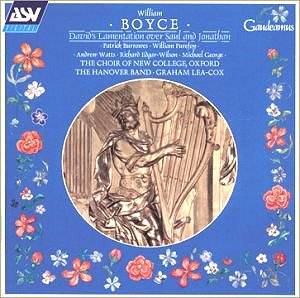WILLIAM BOYCE
David's Lamentation over Saul and Jonathan. Ode for St Cecilia's Day
The Charms of Harmony Display.- first version.
 Patrick Burrowes (boy soprano),
William Purefoy (alto), Andrew Watts (counter-tenor), Richard Edgar-Wilson
(tenor), Michael George (bass-baritone), Choir of New College Oxford, The
Hanover Band/Graham Lea-Cox.
Patrick Burrowes (boy soprano),
William Purefoy (alto), Andrew Watts (counter-tenor), Richard Edgar-Wilson
(tenor), Michael George (bass-baritone), Choir of New College Oxford, The
Hanover Band/Graham Lea-Cox.
 ASV GAUDEAMUS CD GAU
208.
ASV GAUDEAMUS CD GAU
208.
Crotchet
Amazon
UK
AmazonUS

There's a nice touch to the performances here, for the players and singers
involved are reading from facsimiles of Boyce's original manuscript parts,
and the fact that occasional graffiti or comments are apparently to be found
on them brings home to us that not much has changed in 300 years when it
comes to players' views of either conductors or composers. The version of
the Lamentation is the Dublin one of 1744 fashioned eight years after
it was originally performed in London for the Apollo Society, whose prime
mover was Boyce's teacher Maurice Greene. It's not a long work but one of
great depth and dramatic effect with some of its best music reserved for
the chorus, such as 'How are the Mighty fallen!', the aria for counter-tenor
'Israel is fall'n, is undone' (the words are by John Lockman), and the duet
'Sad Israel' for male alto and tenor. The inevitability of Handel's influence
(this is Messiah time and Dublin too) is felt in the tenor aria 'How
cou'd Conscience hush her Stings'. You will need to follow the text as clarity
of diction is far from satisfactory but the chorus blends splendidly, and,
as authenticity demands, there's not a female voice anywhere among either
soloists or choir. Somehow the power of the middle and low registers of Andrew
Watts' counter-tenor lacks penetration at times but Boyce's imaginative writing
for the orchestra is exploited to the full by the excellent Hanover Band.
The CD ends with three short numbers from the Lamentation as they
appeared in the original London version. The aria 'On Thee, Mount Gilboa'
is vocally an improvement in this form for tenor on the earlier version for
counter-tenor, although the omission of flutes in the later version becomes
a cause for regret.
The Ode (possibly written in 1737 or 1738) is quite another matter in terms
of mood, nothing like so gloomy. It gets a terrific kick-start with the addition
to the band of trumpet and drums in the Overture at a brisk and lively tempo.
Then follows a courtly minuet, played with poised phrasing, and an exquisite
trio in which string section leaders shine. Highlights include an opening
chorus which alternates homophonic and highly contrapuntal textures, a colourful
trio for boy treble, male alto and bass-baritone excellently sung by all
three including St Paul's chorister Patrick Burrowes, a lengthy but punchy
call to arms by Michael George in a fiercesomely difficult aria sung con
bravura, and a jolly choral finale.
This CD is the third in the series ASV are putting together of choral works
by Boyce; a fourth to come later this year will be the Pindaric Ode
and a late Court Ode. The one reviewed here was recorded at the Old Market
in Hove where the Hanover Band has its home.
Christopher Fifield
See also review by Philip Scowcroft

